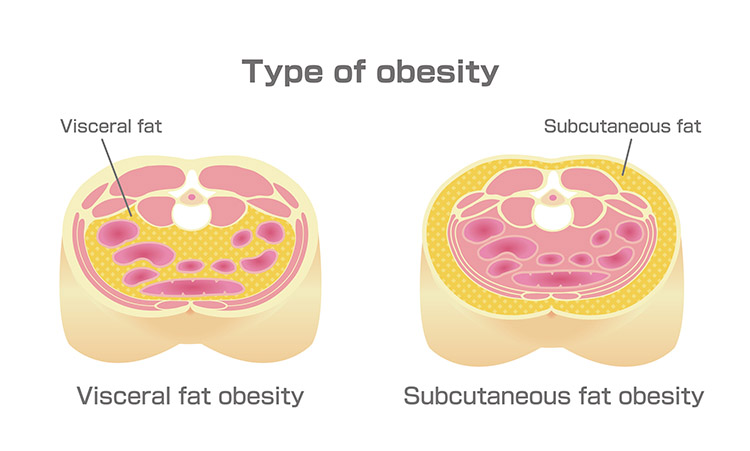Artificial Intelligence in Medicine: Predicting Risk of Heart Attack or Stroke Based on CT Scans
These days, it’s more important than even to protect your personal privacy and keep your information secure. Every day, we hear about identity theft, hackers, cybercrime, and security breaches. Just the thought of a thief or cyberattack penetrating not only our individual virus protection, firewalls, etc. but also those of our banking security or credit card companies sends shivers down our spine. Given the ever-present threat, we want our most important information to remain hidden, invisible to outsiders.
However, there is a different threat that lurks hidden within our own bodies. We hardly even know it’s there, let alone the danger it poses to life itself. It’s called visceral fat.
Visceral fat is dangerous
Not all fat is necessarily unhealthy. When you get out of the shower, unless your bathroom mirror is fogged up, you may observe plump places on your body that jiggle when you move. This is called subcutaneous fat (sub = under, cutaneous = related to skin) that has accumulated under the skin. You might not like how it looks, but it’s usually harmless—provided it’s not the result of obesity.
Visceral or abdominal fat, on the other hand, means fat within your body that surrounds the organs in your abdominal cavity. You can’t see it or feel it from the outside, but it’s part of your body’s “private” information about your health. It’s estimated to be about 10% of your total body fat. The more total body fat you carry, the more visceral fat you have, and the more damage it’s doing. Visceral fat is highly associated with stroke, heart attacks, cardiovascular disease, diabetes, colorectal cancer, breast cancer, and Alzheimer’s disease.

The problem lies in its invisibility. Your doctor can’t see it by looking at or weighing you, so the rule of thumb for estimating your level of visceral fat is having both a high Body Mass Index (BMI) and a large waist (35 or more inches for women, 40 or more inches for men). You can find a BMI calculator here.
However, these calculations amount to educated guessing because weight and BMI are “crude surrogates of body composition,” according to Kirti Magudia, M.D., Ph.D., an abdominal imaging and ultrasound fellow at the University of California San Francisco. Dr. Magudia states, “It’s well established that people with the same BMI can have markedly different proportions of muscle and fat. These differences are important for a variety of health outcomes.”[i]
Finding visceral fat—and predicting fatality risk
Since visceral fat can’t be seen, and proportions may vary from one person to another, the most reliable way to evaluate it is by making it visible through imaging. Where weight, height, waist size, and other measures can approximate visceral fat levels, a picture is worth a thousand such measurements. This is where you WANT such important “private” information to be accessible to an outsider—in this case, a doctor. With efficiency and incredible accuracy, a single CT “slice” of the abdomen reveals the volume and area of visceral fat, as well as subcutaneous fat and skeletal muscle.
However, simply observing the visceral fat does not predict how much danger it poses for the individual involved. This is where Artificial Intelligence (AI) comes into play. Dr. Magudia and her colleagues developed a specific method of AI called deep learning to very quickly calculate a body’s composition metrics (proportion of subcutaneous fat area, visceral fat area, and skeletal muscle area) from abdominal CT scans.
The team submitted over 30,000 abdominal CT scans from 23,136 patients for analysis. From these, they identified 12,128 patients who had no cancer or major cardiovascular diagnosis at the time of the scan. They followed these patients for five years, and found that 1,560 of them had heart attacks and 938 had strokes.
By comparing the AI-determined body composition metrics of these patients with the other 9630 patients, the researchers found that visceral fat was independently linked with future heart attack and stroke, while BMI was not. Put another way, an automated analysis of visceral fat CT images is a better predictor of a catastrophic medical event that either weight or BMI.
“This work shows the promise of AI systems to add value to clinical care by extracting new information from existing imaging data,” Dr. Magudia said. “The deployment of AI systems would allow radiologists, cardiologists and primary care doctors to provide better care to patients at minimal incremental cost to the health care system.”[ii]
The contribution of Dr. Magudia and her teammates can readily be ramped up for large clinical care systems as well as research studies. This timesaving deep learning tool will be an advantage for busy clinicians, and patients will benefit from the previously hidden physical evidence that lifestyle changes are in order.
The lesson: protect your private business and banking information from the world of virtual criminals, but protect your life by applying AI to reveal the secret health criminal hiding in your own body.
NOTE: This content is solely for purposes of information and does not substitute for diagnostic or medical advice. Talk to your doctor if you are experiencing pelvic pain, or have any other health concerns or questions of a personal medical nature.
[i] “AI Abdominal Fat Measure Predicts Heart Attack and Stroke.” RSNA Press Release, Dec. 2, 2020. https://press.rsna.org/timssnet/media/pressreleases/14_pr_target.cfm?ID=2235
[ii] Ibid.
- CATEGORY:
- Artificial Intelligence, General Medicine


